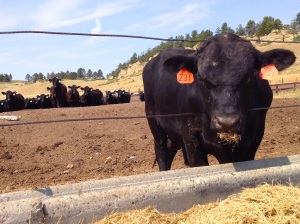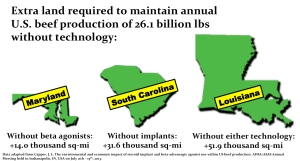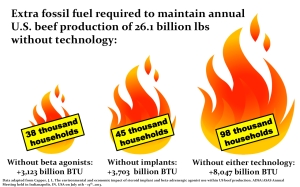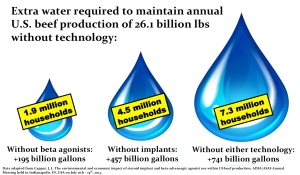 Can we really afford to lose the sustainability advantages that productivity-enhancing tools provide?
Can we really afford to lose the sustainability advantages that productivity-enhancing tools provide?
Beta agonists have been a hotly debated topic in the media recently, after it was suggested that the use of Zilmax™ might be related to welfare issues in supplemented cattle (see note 1), and Tyson announced that they would not purchase cattle produced using the feed supplement.
As the global population increases and consumer interest in food production sustainability continues to grow, we know that to maintain the continuous improvements in beef sustainability that we’ve seen over the past half-century, we need to ensure that economic viability, environmental responsibility and social acceptability are all in place. All cattle producers obviously have the choice as to what tools and practices are used within their operation, but what are the big picture environmental and economic implications of removing technology use from beef production? Let’s look at two tools – beta agonists and implants (see note 2 below for an explanation of these tools).
 In a traditional beef production system using both tools, we’d need 85 million total cattle (see note 3) to maintain the U.S. annual production of 26 billion lbs of beef (see note 4). If we removed beta-agonists from U.S. beef production we’d need an extra 3.5 million total cattle to support beef production; losing access to implants would require an extra 9.9 million cattle; and removing both tools would increase total cattle numbers to 100 million (a 15 million head increase) to maintain the current beef supply (see note 5).
In a traditional beef production system using both tools, we’d need 85 million total cattle (see note 3) to maintain the U.S. annual production of 26 billion lbs of beef (see note 4). If we removed beta-agonists from U.S. beef production we’d need an extra 3.5 million total cattle to support beef production; losing access to implants would require an extra 9.9 million cattle; and removing both tools would increase total cattle numbers to 100 million (a 15 million head increase) to maintain the current beef supply (see note 5).
If we need more cattle to maintain beef supply, we use more resources and have a greater carbon footprint.
If we removed beta-agonists, we would need more natural resources to maintain U.S. beef production:
- More water, equivalent to supplying 1.9 million U.S. households annually (195 billion gallons)
- More land, equivalent to an area just bigger than Maryland (14.0 thousand sq-miles)
- More fossil fuels, equivalent to heating 38 thousand U.S. households for a year (3,123 billion BTU)
If we removed implants, we would need more natural resources to maintain U.S. beef production:
- More water, equivalent to supplying 4.5 million U.S. households annually (457 billion gallons)
- More land, equivalent to the area of South Carolina (31.6 thousand sq-miles)
- More fossil fuels, equivalent to heating 45 thousand U.S. households for a year (3,703 billion BTU)
If we removed both beta-agonists and implants, we would need more natural resources to maintain U.S. beef production:
- More water, equivalent to supplying 7.3 million U.S. households annually (741 billion gallons)
- More land, equivalent to the area of Louisiana (51.9 thousand sq-miles)
- More fossil fuels, equivalent to heating 98 thousand U.S. households for a year (8,047 billion BTU)

 Beef production costs would also increase if these tools weren’t used. Feed costs would increase by 4.0% without beta-agonists, 8.1% without implants and 11.0% without both tools. These costs ultimately would be passed on through every segment of the beef supply chain (including the retailer or food service segment) and ultimately onto the consumer, making beef a less-affordable protein choice.
Beef production costs would also increase if these tools weren’t used. Feed costs would increase by 4.0% without beta-agonists, 8.1% without implants and 11.0% without both tools. These costs ultimately would be passed on through every segment of the beef supply chain (including the retailer or food service segment) and ultimately onto the consumer, making beef a less-affordable protein choice.
In a world where one in seven children currently do not have enough food, keeping food affordable is key to improving their health and well-being. If we use productivity-enhancing tools in one single animal, the extra beef produced is sufficient to supply seven schoolchildren with their beef-containing school meals for an entire year. Is that a social sustainability advantage that we can afford to lose?
Although animal welfare is paramount for all beef production stakeholders from the cow-calf operator to the retailer, it is possible that the consumer perception of productivity-enhancing tools may be harmed by negative comments on media articles relating to Zilmax™. There is no doubt that we will need to use technologies within food production in order to feed the growing global population, yet we need consumer acceptance of both the technologies that we use, and the reasons why we use them, in order to continue to secure market access for U.S. beef.
Consumer acceptance therefore needs to be a key component of our mission to continuously improve beef sustainability. That does not mean giving in to the uninformed whims of those who blithely assert that we could feed the world by returning to the production systems of the 1940’s or ’50s, but does offer an opportunity to reach out, listen to and engage in a dialogue with our friends, family, customers and colleagues about the advantages that technology offers. We have a bright future ahead, but only if we keep the torch alight.
To read more conversation about the use of technologies within beef production (including the real-life experiences of feedyard operators who use these tools) and for facts and figures relating to beef production, please check out the following websites: Feedyard Foodie, Ask a Farmer, Facts About Beef, and the U.S. Farmers and Ranchers Alliance.
Footnotes
1) Merck Animal Health have since pledged to conduct a thorough investigation into the issue and have temporarily suspended Zilmax™ sales in the U.S. and Canada.
2) Beta agonists are animal feed ingredients that help cattle maintain their natural muscle-building ability and add about 20-30 pounds of additional lean muscle instead of fat. Implants (sometimes called growth promotants or growth hormones), are placed into the ear and release hormones slowly, helping cattle maintain natural muscle-building ability while also decreasing the amount of fat gained.
3) Includes beef cows, calves, bulls, replacement animals, stockers and feedlot cattle plus calves and cull cows from the dairy system.
4) Although this is a considerable amount of beef, it’s still not enough to fulfill current demand for beef in the USA and overseas.
5) This work was presented as a poster at the Joint Annual Meeting of the American Dairy Science Association and American Society of Animal Science in Indianapolis, IN in July 2013. The poster is available for download here.

Thank you for this great post, and also for all of the terrific work that you do to help me be a better farmer!
All the best,
Anne
LikeLike
Thanks Anne! You do a wonderful job with your blog – I love it!
LikeLike
Pingback: Ask a Farmer: Beta Agonists and Cattle Feeding | Agriculture Proud
Thanks for the post. This is a great article and brings a lot of aspects to the table for discussion.
Animal welfare is and has to remain a top priority for producers to gain social acceptability. While I have worked personally with ZIlmax in thousands of cattle and never had the issues described with lameness and aggression, I think it’s important that we take the proper time to evaluate whether it is a healthy choice for our animals. This step will show the public we do not tolerate unhealthy or unhappy animals, and that will gain trust. And hopefully, Merck and other studies will find no correlation to the problems they’ve been seeing.
As far as the hungry children and increased cattle numbers that would be required if this was a permanent change, those are issues facing all agriculture that unfortunately don’t have answers coming any time soon, in my opinion. If we want to meet the demand for cheap food, are we willing to only feed those too desperate for food or those that cannot afford to have an opinion on how the animals are raised? Are we going to be able to disregard the (sometimes uniformed and untrue, sometimes legitimate) concerns of middle and upper class consumers under the counter-argument that we have to be bigger (in lbs supplied) rather than listen to their concerns? I hope we never have to make that either/or decision. It’s up to us to squash the false information, therefore reducing the fear and mystery in consumers. It’s up to us to show we take valid concerns seriously, and will do what it takes to show them they can trust us to provide care and rationale to the entire line of production.
LikeLike
Excellent comments Valerie – thanks! I kept away from commenting on the animal welfare issues in the post because my area is more on the environmental and nutrition side, but I completely agree – where concerns are legitimate we have to address them. That even extends to those that are not legitimate but that arise from misinformation that, alas, spreads so fast in the high-tech world that we live in. Everybody’s opinion matters – what concerns me is that often misinformation gets supplied as fact and is taken on-board by those who make decisions relating to what is supplied to the consumer (e.g. Panera Bread’s current TV ads featuring “antibiotic-free ham” and thus implying that all other ham contains antibiotics). If I had a good answer as to how we get facts out to everybody and allow them to make informed decisions on food purchases, whatever those decisions might be, my mission would be complete!
LikeLike
Perhaps there is a way to increase productivity with genetic selection. Some cattle are simply better than others. Wouldn’t that be a win-win situation?
LikeLike
I think we need to make use of all the tools that are available to us. Improved nutrition, genetics, management and welfare have helped us make great gains over the years, and should continue to do so in future, as should technologies. I wish there was a simple “one-size-fits-all” answer that we could apply in every operation, but different regions, herd sizes and objectives are always going to lead to a number of goals, even with productivity. If we could target our cattle to our specific operations and provide them with optimal nutrition and health, now that would be a win-win!
LikeLike
Be sure to continue to point out that all of a cow’s feed and most of a slaughter animal is WASTE PRODUCTS. Grass and cornstalks are not something that can be used effectively by people – but CAN be converted into high-quality beef.
LikeLike
Great article.
LikeLike
Pingback: Is it OK To Drink Milk & Eat Beef If You Care About Animals?